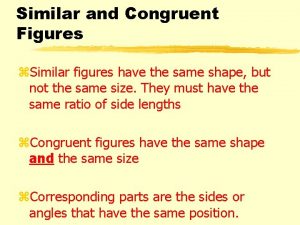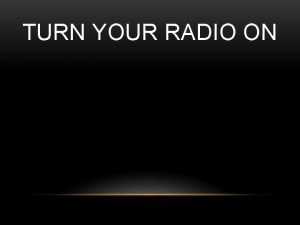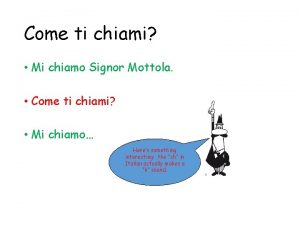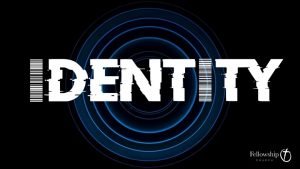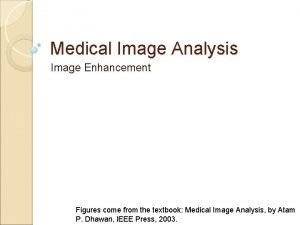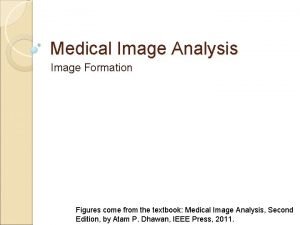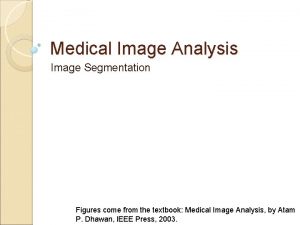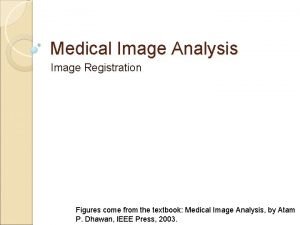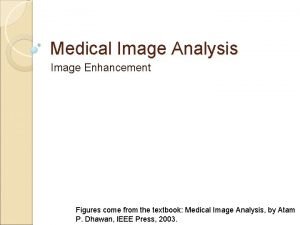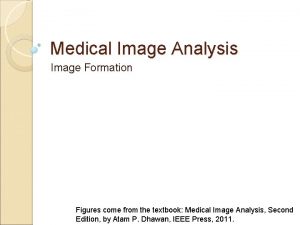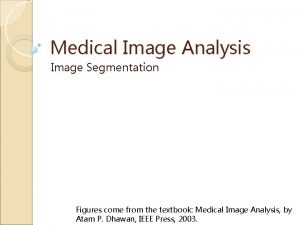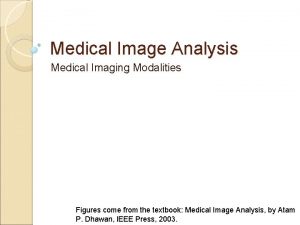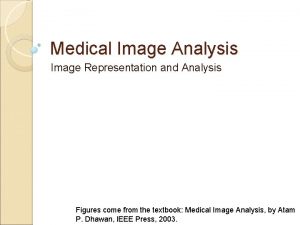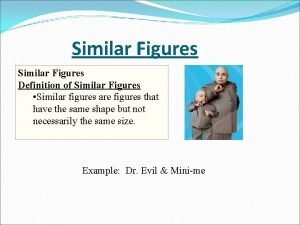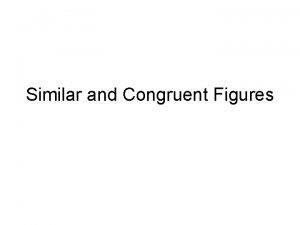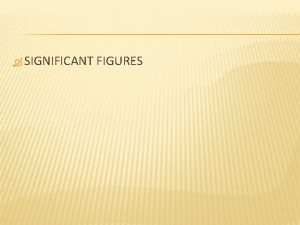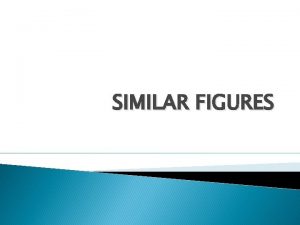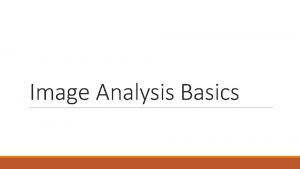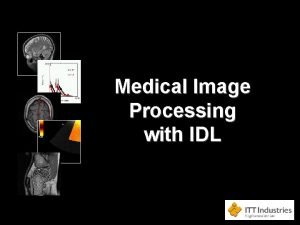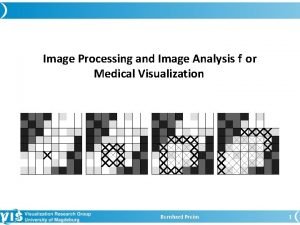Medical Image Analysis Introduction Figures come from the


































- Slides: 34

Medical Image Analysis Introduction Figures come from the textbook: Medical Image Analysis, Second Edition, by Atam P. Dhawan, IEEE Press, 2011.

Modalities X-ray Computed Tomography (X-ray CT) Magnetic Resonance Imaging (MRI) Single Photon Emission Computed Tomography (SPECT) Positron Emission Tomography (PET) Ultrasound Figures come from the textbook: Medical Image Analysis, Second Edition, by Atam P. Dhawan, IEEE Press, 2011.

An X-ray mammogram Figures come from the textbook: Medical Image Analysis, Second Edition, by Atam P. Dhawan, IEEE Press, 2011.

An X-ray CT Figures come from the textbook: Medical Image Analysis, Second Edition, by Atam P. Dhawan, IEEE Press, 2011.

A PET Figures come from the textbook: Medical Image Analysis, Second Edition, by Atam P. Dhawan, IEEE Press, 2011.

An MRI Figures come from the textbook: Medical Image Analysis, Second Edition, by Atam P. Dhawan, IEEE Press, 2011.

An ultrasound Figure comes from the Wikipedia, www. wikipedia. org.

Medical image modalities ◦ Energy ◦ Anatomical, physiological, or functional ◦ External, internal, or combination Figures come from the textbook: Medical Image Analysis, Second Edition, by Atam P. Dhawan, IEEE Press, 2011.

TV Waves Radio Waves 103 102 101 1 Radar Waves 10 -1 10 -2 Microwaves Infrared Rays 10 -3 10 -5 10 -4 10 -6 Visible Light Ultraviolet Rays 10 -7 10 -8 Gamma Rays X-rays Cosmic Rays 10 -9 10 -10 10 -11 10 -12 10 -13 10 -14 1017 1018 1021 Wavelength in meters 105 106 107 108 109 1010 1011 1012 1013 1014 1015 1016 1019 1020 1022 Frequency in Hz 10 -10 10 -9 10 -8 10 -7 10 -6 10 -5 10 -4 10 -3 10 -2 10 -1 1 102 103 104 105 106 107 Energy in e. V MRI X-ray Imaging Gamma-ray Imaging Figure 1. 2: Different sources of imaging modality in the electromagnetic spectrum. Figures come from the textbook: Medical Image Analysis, Second Edition, by Atam P. Dhawan, IEEE Press, 2011.

Medical Imaging Modalities Source of Energy Used for Imaging Internal External Nuclear Medicine: Single Photon Emission Tomography (SPECT) X-Ray Radiographs X-Ray Mammography Nuclear Medicine: Positron Emission Tomography (PET) X-Ray Computed Tomography Ultrasound Imaging and Tomography Combination: External and Internal Magnetic Resonance Imaging: MRI, PMRI, FMRI Optical Fluorescence Imaging Electrical Impedance Imaging Optical Transmission and Transillumination Imaging Figures come from the textbook: Medical Image Analysis, Second Edition, by Atam P. Dhawan, IEEE Press, 2011.

Figure 1. 1. A collaborative multidisciplinary paradigm of medical imaging research and applications. Figures come from the textbook: Medical Image Analysis, Second Edition, by Atam P. Dhawan, IEEE Press, 2011.

From Physiology to Information Processing Understanding image medium ◦ Tissue density, blood flow, perfusion, cardiac motion Physics of imaging ◦ Transmission of X-rays, emission of gamma rays, MR imaging Imaging instrumentation ◦ Collecting the data, signal-to-noise ratio, resolution Figures come from the textbook: Medical Image Analysis, Second Edition, by Atam P. Dhawan, IEEE Press, 2011.

Data acquisition methods for image formation ◦ Active filtering, post-processing methods ◦ Back-projection, iterative and Fourier transform methods Imaging processing and analysis ◦ Enhancement, transformations, features of interest Figures come from the textbook: Medical Image Analysis, Second Edition, by Atam P. Dhawan, IEEE Press, 2011.

General Performance Measures Positive: Object was observed Negative: Object was not observed True Positive False Negative True Negative False Positive Figures come from the textbook: Medical Image Analysis, Second Edition, by Atam P. Dhawan, IEEE Press, 2011.

True Condition Object is present. Object is observed. Object is NOT present. True Positive False Negative True Negative Observed Information Object is NOT observed. Figure 1. 4. A conditional matrix for defining four basic performance measures as defined in the text. Figures come from the textbook: Medical Image Analysis, Second Edition, by Atam P. Dhawan, IEEE Press, 2011.

TPF a b c TNF Figure 1. 5: ROC curves with curve “a” indicating better overall classification ability than the curve “b” while the curve “c” shows the random probability. Figures come from the textbook: Medical Image Analysis, Second Edition, by Atam P. Dhawan, IEEE Press, 2011.

Sensitivity Specificity Accuracy Figures come from the textbook: Medical Image Analysis, Second Edition, by Atam P. Dhawan, IEEE Press, 2011.

An example of feature-adaptive contrast enhancement processing as applied to a mammogram to enhance microcalcification areas ◦ Histogram equalization Figures come from the textbook: Medical Image Analysis, Second Edition, by Atam P. Dhawan, IEEE Press, 2011.

Figure 1. 6. (a) A part of the digitized breast film-mammogram with microcalcification areas. (b): Enhanced image through feature adaptive contrast enhancement algorithm. (c): Enhanced image through histogram equalization method. Figures come from the textbook: Medical Image Analysis, Second Edition, by Atam P. Dhawan, IEEE Press, 2011.

MATLAB Image Processing Toolbox Basic MATLAB image toolbox commands pic = imread(f); pic = rgb 2 gray(pic); imagesc(pic); qb = fftshift(log(abs(fft 2(pic)))); Figures come from the textbook: Medical Image Analysis, Second Edition, by Atam P. Dhawan, IEEE Press, 2011.

Imagepro Interface in MATLAB Environment and Image Databases


Image. J and Other Image Processing Software Packages Image. J 3 D Slicer Mango MRIcro Figures come from the textbook: Medical Image Analysis, Second Edition, by Atam P. Dhawan, IEEE Press, 2011.

Selected slices for the course Chapters 2 -12 Figures come from the textbook: Medical Image Analysis, Second Edition, by Atam P. Dhawan, IEEE Press, 2011.

Figure 2. 7. (a) An image with a square region at the center and (b) the logarithmic magnitude image of its Fourier transform. Figures come from the textbook: Medical Image Analysis, Second Edition, by Atam P. Dhawan, IEEE Press, 2011.

Radiation Interaction with Matter m/r (cm 2/g) 1. 0 Compton Scattering Total Mass Attenuation Coefficient Photoelectric Absorption Scattering Rayleigh Scattering 0 Photon Energy (ke. V) 0 10 0 50 0 Figure 3. 1. The mass attenuation coefficients of water under the 511 ke. V energy range. Figures come from the textbook: Medical Image Analysis, Second Edition, by Atam P. Dhawan, IEEE Press, 2011.

Figure 4. 7: The translate-rotate parallel-beam geometry of first generation CT scanners. Figures come from the textbook: Medical Image Analysis, Second Edition, by Atam P. Dhawan, IEEE Press, 2011.

S Lower Energy Level H 0 Higher Energy N Level Figure 4. 15 (a). Nuclei aligned under thermal equilibrium in the presence of an external magnetic field. (b). A non-zero net longitudinal vector and a zero transverse vector provided by the nuclei precessing in the presence of an external magnetic field. Figures come from the textbook: Medical Image Analysis, Second Edition, by Atam P. Dhawan, IEEE Press, 2011.

Z 1 Z 3 Z 2 Z 4 Z 5 I 0 T 1, 2 T 2, 3 T 3, 4 T 5, 4 T 4, 3 T 3, 2 T 2, 1 R 0 x 1 x 2 x 3 Figure 4. 39. A path of a reflected sound wave in a multilayered structure. Figures come from the textbook: Medical Image Analysis, Second Edition, by Atam P. Dhawan, IEEE Press, 2011.

y q p f(x, y) q x p P(p, q) q Figure 2. 8. Line integral projection P(p, q) of the two-dimensional Radon transform. Figures come from the textbook: Medical Image Analysis, Second Edition, by Atam P. Dhawan, IEEE Press, 2011.

Figure 6. 1. An X-ray CT image (top left) and T-2 weighted proton density image (top right) of human brain cross-sections with their respective histograms at the bottom. The MR image shows a brain lesion.

Figure 7. 4. Two segmented MR brain images using a gray value Figures the textbook: Medical Image Analysis, Second threshold T=166 come (top)from and T=225 (bottom). Edition, by Atam P. Dhawan, IEEE Press, 2011.

Figure 8. 10. Example of morphological operations on MR brain image using a structuring element of (a) the original MR brain image; (b) the thresholded MR brain image for morphological operations; (c) dilation of thesholded MR brain image; (d) resultant image after 5 successive dilations of the thresholded brain image; (e) erosion of the thresholded MR brain image; (f) closing of thesholded MR brain image; (g) opening of the thresholded MR brain image; and (h) morphological boundary detection on the thresholded MR brain image.

Figures 9. 7 a, b and c: Sequential slices of MR (middle rows) and PET (bottom rows) and the registered MR-PET brain images (top row) of the corresponding slices using the IPAR method.
 Come rico
Come rico Two shapes that are congruent are also similar
Two shapes that are congruent are also similar A polygon with eight sides and eight angles
A polygon with eight sides and eight angles Washing machine solid or plane figure
Washing machine solid or plane figure Come holy spirit come inflame our souls with love lyrics
Come holy spirit come inflame our souls with love lyrics Hey, come on out answer key
Hey, come on out answer key Come thou fount come thou king lyrics
Come thou fount come thou king lyrics Have has
Have has Emmanuel son of god
Emmanuel son of god Come mi chiamo
Come mi chiamo Through all generations everlasting is his mercy
Through all generations everlasting is his mercy Softly and tenderly jesus is calling
Softly and tenderly jesus is calling Come mi vedo io come mi vedono gli altri
Come mi vedo io come mi vedono gli altri Turn on your radio
Turn on your radio Come mi chiamo come mi chiamo
Come mi chiamo come mi chiamo Drik en pasado simple
Drik en pasado simple Come in and sit down
Come in and sit down Come in come in and sit down
Come in come in and sit down Come let us create man in our own image
Come let us create man in our own image Hát kết hợp bộ gõ cơ thể
Hát kết hợp bộ gõ cơ thể Lp html
Lp html Bổ thể
Bổ thể Tỉ lệ cơ thể trẻ em
Tỉ lệ cơ thể trẻ em Chó sói
Chó sói Chụp tư thế worms-breton
Chụp tư thế worms-breton Hát lên người ơi
Hát lên người ơi Môn thể thao bắt đầu bằng từ chạy
Môn thể thao bắt đầu bằng từ chạy Thế nào là hệ số cao nhất
Thế nào là hệ số cao nhất Các châu lục và đại dương trên thế giới
Các châu lục và đại dương trên thế giới Công thức tiính động năng
Công thức tiính động năng Trời xanh đây là của chúng ta thể thơ
Trời xanh đây là của chúng ta thể thơ Mật thư tọa độ 5x5
Mật thư tọa độ 5x5 Làm thế nào để 102-1=99
Làm thế nào để 102-1=99 độ dài liên kết
độ dài liên kết Các châu lục và đại dương trên thế giới
Các châu lục và đại dương trên thế giới

